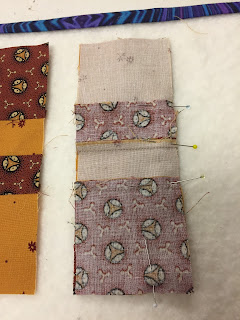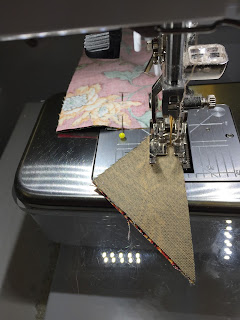It's probably no surprise that I love to teach quiltmaking. Today starts the 2018 Sunday Sew and Sews monthly class, where we will work on the Block of the Month from The Quilt Show: The Patchwork Barn. Here are the excited students who are joining in:
While I've been teaching quilting for almost 30 years, mostly locally and regionally, once I retired from H&R Block in 2014 AND had my Red and White By the Numbers quilt front and center for the 40th anniversary of the International Quilt Festival in Houston, I began traveling more out of state to teach. 2018 finds me with 9 trips away from home, starting next week at Road to California, a big show on the West Coast, that has been in business for a long time. I am honored and excited to be among the 55 faculty members for this week-long Quilters Conference. And so pleased that both my one day classes are FULL and the two-day class only has room for a few more students--that amazes me! We are going to have a great time.
For almost 20 years my job at the Quilts Inc. shows has been Faculty Check-In. This has given me a great gift--I've developed both personal and professional relationships with the top quilt teachers in the world, most of whom are household names but all of whom are top-notch teachers. I thought I understood what they go through to get ready to teach at a big venue like Houston or Road. Not until I shipped two boxes of class supplies, totaling more than 35 pounds of patterns, templates, handouts and a few of my best quilts, did I really understand the terror that can come from a lost box. When FedEx notified me they could not deliver the boxes because the business was "closed" and I quickly found out the business was OPEN, and redelivery would be "attempted" four days later, due to Christmas, yes, that was a bit of panic-time. Fortunately, the boxes made it safely to their destination the day after Christmas and I learned a valuable lesson--ship EARLY, not the week before Christmas.
Here is what Faculty Freight looks like in Houston, and you can only see half of it here. This is BEFORE the faculty arrive, when I have it all neatly organized alphabetically:
This is AFTER, as the boxes start to be opened and used:
When I see a teacher entering the Education office for the first time, I have already checked my "freight list" so I can tell her/him, how many boxes have safely arrived for them. They are shipped to a show office and then transported to the Education office at these big shows--so just because the teacher knows the boxes made it to the place they were shipped, they aren't really "here" until you can lay your eyes and hands on them where you need them--at the show convention center.
And before you think it must be glamorous to be a traveling professional quilt teacher, think about the "travel" part of that title:
Add weather issues for all of us who fly to these shows and you can imagine a bit of the excitement
and stress. Of course, going to Southern California in the dead of winter isn't a bad gig...
This week I'll prep all 3 of my class materials, review everything I plan to teach and how I plan to teach it, get the remaining supplies, tools and quilt samples all together, figure out what to wear each day for a week when time is of the essence, and get really excited to meet the many new students who are in my classes. I am also doing the Roundabout, a two hour demo session--mine is on top tricks and tips to make great bindings. I need to get those samples ready too. Look for a report when I get back.
Also this week I will make two shop samples for upcoming classes, one on Ruler Work with a domestic sewing machine and one a small quilt. I want them done before I leave town for a week.
It's Stella time--my adorable two and a half year old grand-girl visited us for Christmas, for about two days, along with her mom and dad. Last Spring Lauren, my DIL, asked for "mother/daughter" aprons so for Christmas I made:
I was glad to see they fit--they are "cross-back" style, which means no buttons or ties and that head-hole on Stella's looked pretty small to me without being able to try it on her. She loves to help Mommy in the kitchen. And I did get her to sit still for a few minutes so she could show me her IPad:
I hope you have plans to make a quilt or two this year.
Let's Quilt!
Barbara

































































